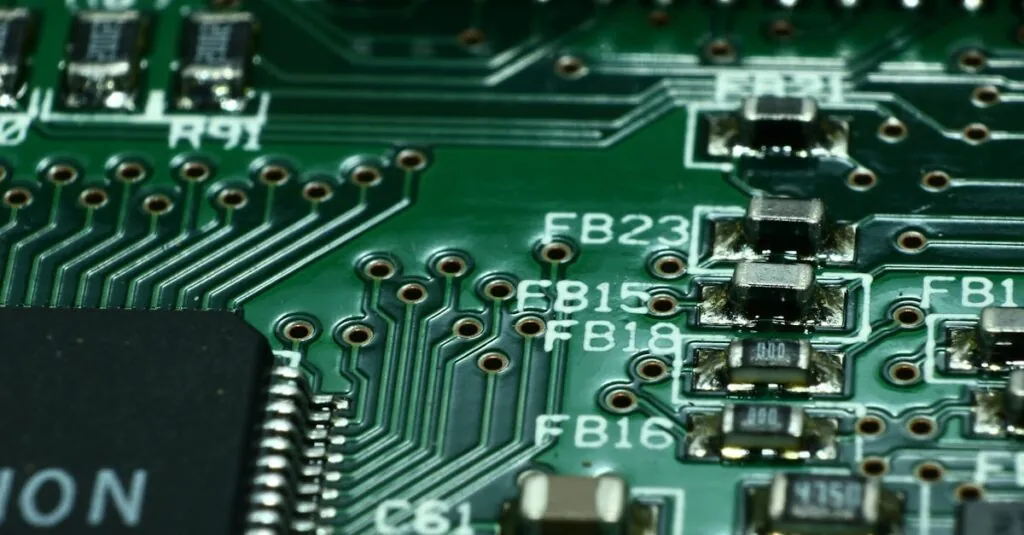Table of Contents
ToggleIn a world where gadgets seem to multiply faster than rabbits, the impact of electronics on our planet can feel overwhelming. Enter eco-friendly circuit boards—the unsung heroes of the tech realm. These innovative boards not only keep your devices running smoothly but also help save the environment, one solder joint at a time. It’s like giving Mother Nature a high-five while you scroll through your social media feed.
Overview of Eco-Friendly Circuit Boards
Eco-friendly circuit boards represent a significant advancement in electronics manufacturing. These boards utilize sustainable materials that reduce reliance on harmful substances typically found in traditional circuit boards. Manufacturers often replace toxic components with biodegradable or recyclable options, minimizing environmental impact.
Materials like paper and bioplastics are commonly used in the production of eco-friendly circuit boards. Utilizing these alternatives not only reduces pollution but also encourages resource efficiency. Innovations such as water-soluble solder and lead-free components further enhance the sustainability of these products.
Energy-efficient manufacturing processes contribute to the positive environmental impact of eco-friendly circuit boards. Some companies implement practices that lower energy consumption during production. Optimized supply chains also play a role by reducing transportation emissions linked to sourcing materials.
Regulatory bodies increasingly recognize the importance of eco-friendly circuit boards. Certifications and standards, such as RoHS and WEEE, guide manufacturers in meeting sustainability benchmarks. Compliance with these regulations results in greater market acceptance and consumer trust.
In various applications, eco-friendly circuit boards support the functionality and longevity of electronic devices. Consumer electronics, automotive systems, and medical devices can all benefit from greener solutions. Their design often prioritizes modularity, making repairs and upgrades easier while extending product life cycles.
Cost considerations remain vital for manufacturers and consumers alike. Despite initial costs, eco-friendly circuit boards lead to savings in waste management and compliance. Investing in sustainable technology offers long-term financial benefits alongside environmental advantages.
Benefits of Eco-Friendly Circuit Boards
Eco-friendly circuit boards provide numerous benefits that positively impact both the environment and the economy. These advancements signal a shift towards sustainable electronics manufacturing.
Environmental Impact
Eco-friendly circuit boards utilize materials that minimize pollution and waste. Biodegradable components, like paper and bioplastics, reduce the accumulation of harmful substances in landfills. Water-soluble solder and lead-free components contribute further to this reduction, promoting a safer ecosystem. By reducing reliance on toxic materials, manufacturers help preserve natural resources. Certifications such as RoHS and WEEE support manufacturers in meeting sustainability standards. Consequently, the adoption of these certifications fosters consumer trust and encourages responsible production practices.
Economic Advantages
Economic benefits accompany the shift towards eco-friendly circuit boards. Investing in sustainable technology leads to long-term savings in waste management costs. Manufacturers enjoy reduced disposal fees through the use of recyclable materials. Modular designs facilitate easier repairs and upgrades, extending product lifecycles while minimizing replacement expenses. Energy-efficient manufacturing processes can also lower production costs over time. As consumer awareness increases, demand for sustainable products is expected to rise, driving growth in the eco-friendly electronics market. Thus, a commitment to sustainability not only helps the planet but also enhances financial performance.
Types of Eco-Friendly Circuit Boards
Eco-friendly circuit boards encompass various types that leverage sustainable materials and technologies. These boards contribute to environmental preservation while maintaining device performance.
Biodegradable Materials
Biodegradable materials serve as a primary component in eco-friendly circuit boards. Common examples include polylactic acid and modified paper, which break down naturally over time, reducing landfill contributions. The use of these materials minimizes the presence of toxic substances typically found in traditional boards. Advances in biopolymer technology enhance the durability of these biodegradable options, making them suitable for various applications. By opting for biodegradable components, manufacturers can significantly lessen their environmental impact while meeting consumer demand for greener products.
Recycled Materials
Recycled materials play a crucial role in the production of eco-friendly circuit boards. Electronics manufacturers increasingly incorporate post-consumer plastics and reclaimed metals into their designs. This practice conserves resources and reduces the energy required for raw material extraction. Recycled content in circuit boards supports a circular economy by extending the life of materials already in circulation. Many companies work towards integrating high percentages of recycled materials, balancing sustainability with performance. Utilizing recycled components aligns with regulatory frameworks like RoHS, promoting responsible manufacturing practices.
Manufacturing Processes
Eco-friendly circuit boards rely on advanced manufacturing processes that prioritize sustainability and efficiency. The focus on sustainable practices ensures a lower environmental footprint during production.
Sustainable Practices
Sustainable practices in circuit board manufacturing incorporate renewable materials and methods. Manufacturers increasingly utilize biodegradable substrates, such as polylactic acid and modified paper. These materials break down naturally, minimizing waste. Water-soluble solder replaces traditional solder, reducing harmful chemical usage. Energy-efficient manufacturing techniques lower greenhouse gas emissions and conserve resources. Certifications like RoHS and WEEE guide manufacturers, promoting eco-friendly standards and practices. The adoption of recycled components, including post-consumer plastics, supports a circular economy. By prioritizing sustainability, manufacturers can achieve compliance with regulations while reducing their overall environmental impact.
Innovations in Technology
Innovative technologies play a critical role in the development of eco-friendly circuit boards. Biopolymer advancements enhance the durability of biodegradable options, making them suitable for various applications. Techniques such as additive manufacturing enable the production of intricate designs without excessive material waste. Lead-free materials are becoming standard in circuit board creation, which improves both safety and environmental compliance. The use of reclaimed metals in production aids resource conservation and reduces extraction demands. Automation in manufacturing processes further optimizes efficiency, minimizing waste and energy consumption. As technology evolves, these innovations drive the continuous improvement of sustainable practices in the electronics industry.
Challenges and Limitations
Eco-friendly circuit boards face notable challenges and limitations, particularly in cost and performance.
Cost Considerations
Cost often poses a significant challenge for manufacturers adopting eco-friendly circuit boards. Sustainable materials, such as bioplastics and recycled components, tend to carry a higher price tag compared to traditional options. Investing in advanced manufacturing processes can also increase costs. Initial expenses may deter smaller companies from embracing these technologies. However, long-term savings in waste management and disposal fees can offset some of these higher upfront investments. As demand for eco-friendly products increases, economies of scale could lead to reduced costs over time.
Performance Issues
Performance issues can arise with eco-friendly circuit boards, especially when compared to conventional alternatives. Some biodegradable materials may lack the durability required for high-stress applications. Limitations might affect thermal stability and electrical conductivity. Not all innovations achieve performance metrics on par with traditional boards. Continuous advancements in biopolymer technology and manufacturing techniques aim to address these concerns, enhancing the reliability of these eco-friendly options. Testing and certification processes can also help ensure that these boards meet necessary performance standards across various applications.
Conclusion
The rise of eco-friendly circuit boards marks a pivotal shift in electronics manufacturing. By embracing sustainable materials and innovative processes, they not only enhance device functionality but also promote environmental stewardship. As industries adapt to these advancements, the long-term benefits become increasingly apparent.
Investing in eco-friendly technology is not just a trend; it’s a commitment to a sustainable future. With growing consumer awareness and regulatory support, the demand for these boards is set to increase. This evolution in manufacturing practices will likely lead to reduced costs and improved performance over time.
Ultimately, eco-friendly circuit boards represent a crucial step towards a greener electronics industry, balancing technological progress with environmental responsibility. As the market continues to evolve, their impact on both the economy and the planet will be significant.







